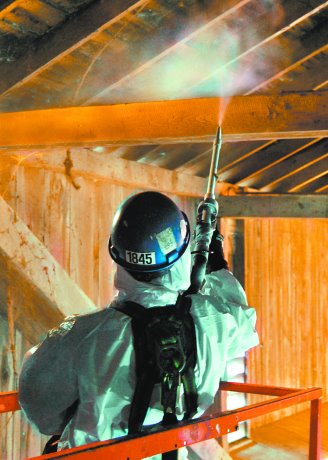Abrasive remediation technologies come and go. Dry ice blasting offers an abrasive technology that comes and goes almost simultaneously.
Frozen carbon-dioxide pellets do the abrasive work, then sublimate, transforming from solid to gas in a split second, leaving no residue.
"People like to say something isn’t rocket science, but in this case it is," says Roger White, president of Wickens Dry Ice Blasting Inc., with offices in Milton, Ont. and Fort McMurray, Alta.
"The technology was fully developed in the 1980s by Lockheed to blast clean the fuel tanks of the space shuttle."
Wickens was founded in 1993 as a distributor of dry ice blasting equipment, but by 2005 developed a contracting business providing dry ice blasting services.
"We offer all sorts of abrasive media, including sand, soda, glass and water blasting, but dry ice is the star of the show," says White. "Its advantage is that it leaves no secondary waste from the abrasive medium because the ice sublimates into a gas and is completely gone. If we’re doing fire remediation, all that’s left behind is the soot."
Dry ice blasting is used in a number of cleaning applications, from industrial to aerospace. Construction specialties include mould remediation, fire restoration, historical restoration, lead paint removal, wood cleaning, roofing restoration and heavy equipment cleanup.
The carbon dioxide used in making the dry ice is a by-product of other chemical processes. The gas is expanded to form CO2 "snow" at -79 degrees Celsius and then formed into dry ice pellets the size of a grain of rice. The pellets are supplied in batches of up to 250 kilograms inside insulated plastic totes that can preserve them for as long as a week.
"Our technicians talk about good ice, which is what you have for the first three days, and bad ice, when the pellets eventually form cavities and have less volume," says White.
The equipment required for dry ice blasting is similar to other abrasive media delivery systems. Technicians use a high volume compressor to force the pellets through a nozzle and eject them at supersonic speeds.
The pellets remove the contaminant in two ways, says White. They first provide abrasive friction as they strike the surface, then provide additional explosive force as they sublimate, expanding to 400 times their volume at the surface of the cleaning site.
"Sandblasting is similar to using an ice pick whereas dry ice blasting is similar to using a spatula," he says. "Sand cuts or chisels away the contaminant, while dry ice helps to lift it away."
Workers wear protective gear to guard against abrasion, but wear respirators only to ensure they don’t breathe in particulates from the surface they’re cleaning.
"Because the pellets are so cold, they’ll burn your skin if you hold on to them," says White. "We train workers in CO2 management, but unless they’re in a small, enclosed space the carbon dioxide isn’t a problem and they don’t require exhaust vents. CO2 is heavier than air and dissipates quickly."
White says that technicians can clean soot from 800 to 1,500 square feet of wall surface per day in fire restoration applications. Steel decking is faster. Cleaning a residential basement of mould using dry ice blasting requires about a day, compared to three or four days for hand work.
"Wood will appear a little lighter than it did after dry ice blasting because we’ve removed a thin veneer of the wood," says White. "On the other hand, if we’re removing paint from brick, the paint can be harder than brick. We would use a softener on the paint first, so we can remove the paint without damaging brick."
A recent fire restoration project in Winnipeg involved a 60,000-square-foot industrial building in which plastic caught fire and the by-products of combustion began to corrode heavy equipment.
"We managed the entire project and provided all of the catastrophe recovery equipment," says White. "Dry ice blasting works particularly well on industrial equipment because it can even clean electrical components, leaving no moisture behind."











Recent Comments
comments for this post are closed